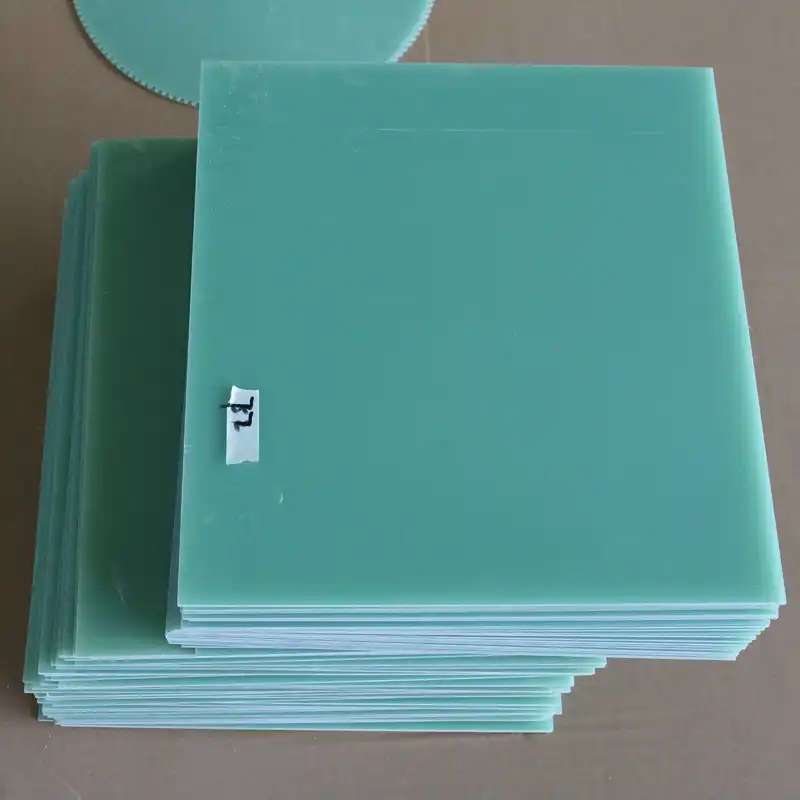FR4 vs Phenolic Paper Sheet: Electrical Insulation Performance
When it comes to electrical insulation in the electronics industry, two materials often come head-to-head: FR4 sheet and phenolic paper sheet. Both have their unique properties and applications, but how do they stack up against each other in terms of electrical insulation performance? FR4, a fiberglass-reinforced epoxy laminate, boasts superior dielectric strength and thermal stability compared to phenolic paper. It excels in high-frequency applications and offers better mechanical properties. On the other hand, phenolic paper sheets are more cost-effective and easier to machine, making them suitable for simpler, low-frequency applications. The choice between these materials ultimately depends on the specific requirements of the application, considering factors such as electrical properties, thermal performance, and cost-effectiveness.

How Do FR4 and Phenolic Paper Compare in Dielectric Strength?
Dielectric Strength Comparison
FR4 sheet exhibits significantly higher dielectric strength compared to phenolic paper sheet. The fiberglass reinforcement and epoxy resin composition of FR4 contribute to its superior insulating properties. Typically, FR4 can withstand electric fields up to 20-30 kV/mm, while phenolic paper sheets generally have dielectric strengths around 10-15 kV/mm. This substantial difference makes FR4 more suitable for high-voltage applications and environments where electrical breakdown must be prevented at all costs.
Frequency Response Characteristics
The frequency response of these materials also differs markedly. FR4 maintains its dielectric properties across a wide frequency range, making it ideal for high-frequency applications in telecommunications and aerospace industries. Phenolic paper, however, tends to exhibit more significant losses at higher frequencies, limiting its use in such applications. The stable dielectric constant of FR4 allows for more precise impedance control in circuit design, a crucial factor in high-speed digital circuits.
Moisture Resistance and Dielectric Stability
Moisture absorption can significantly impact the dielectric properties of insulating materials. FR4 demonstrates superior moisture resistance compared to phenolic paper sheets. This characteristic ensures that FR4 maintains its dielectric strength even in humid environments, whereas phenolic paper may experience a decline in insulating properties when exposed to moisture. The stability of FR4's dielectric properties across various environmental conditions contributes to its reliability in diverse applications.
Thermal and Mechanical Performance Differences
Heat Resistance and Thermal Conductivity
FR4 sheet outperforms phenolic paper in terms of heat resistance. FR4 can typically withstand continuous operating temperatures up to 130°C, with some grades capable of handling even higher temperatures. Phenolic paper sheets, on the other hand, generally have a lower temperature limit, usually around 100-120°C. This superior heat resistance makes FR4 more suitable for applications involving high temperatures or thermal cycling. Additionally, FR4 exhibits better thermal conductivity, which can be advantageous in dissipating heat in electronic assemblies.
Mechanical Strength and Durability
The mechanical properties of FR4 are generally superior to those of phenolic paper sheets. FR4's fiberglass reinforcement provides excellent tensile and flexural strength, making it more resistant to bending and cracking. This robustness is particularly beneficial in applications subject to mechanical stress or vibration. Phenolic paper sheets, while still offering adequate strength for many applications, are more prone to cracking and chipping, especially during machining processes. The superior mechanical properties of FR4 contribute to its longevity and reliability in demanding environments.
Dimensional Stability
Dimensional stability is another area where FR4 sheet excels. FR4 maintains its shape and dimensions more consistently across varying temperatures and humidity levels compared to phenolic paper sheets. This stability is crucial in applications requiring precise tolerances, such as in multilayer printed circuit boards. Phenolic paper sheets may experience more significant dimensional changes with temperature and humidity fluctuations, potentially leading to warping or misalignment in sensitive electronic assemblies.
Material Selection for Reliable Electrical Insulation
Application-Specific Considerations
Choosing between FR4 and phenolic paper sheets for electrical insulation requires careful consideration of the specific application requirements. FR4 is generally preferred in high-performance applications where superior electrical and mechanical properties are essential. It's particularly well-suited for high-frequency circuits, aerospace and defense applications, and situations involving extreme environmental conditions. Phenolic paper sheets, while less robust, remain a cost-effective choice for low-frequency applications, simple electrical insulators, and situations where ease of machining is prioritized over high-performance characteristics.
Cost-Benefit Analysis
While FR4 sheet offers superior performance in many aspects, it comes at a higher cost compared to phenolic paper sheets. For applications where the enhanced properties of FR4 are not critical, phenolic paper can provide adequate insulation at a more economical price point. However, when considering long-term reliability and performance, especially in harsh environments or critical applications, the initial higher cost of FR4 may be justified by its superior durability and performance consistency over time. A thorough cost-benefit analysis, taking into account factors such as expected lifespan, operating conditions, and potential failure costs, is essential in making an informed decision.
Environmental and Regulatory Factors
Environmental considerations and regulatory compliance are increasingly important factors in material selection. FR4, with its flame-retardant properties, meets stringent fire safety standards, making it compliant with various international regulations. Some grades of FR4 are also available in halogen-free versions, addressing environmental concerns. Phenolic paper sheets, while generally considered environmentally friendly due to their organic composition, may not meet the same level of flame retardancy as FR4 without additional treatments. When selecting insulation materials, it's crucial to consider not only current regulations but also potential future environmental and safety standards to ensure long-term compliance and sustainability.
Conclusion
In the realm of electrical insulation, FR4 sheet and phenolic paper sheet each have their place. FR4 stands out with its superior dielectric strength, thermal stability, and mechanical robustness, making it the go-to choice for high-performance applications. Phenolic paper, while less robust, offers a cost-effective solution for simpler, low-frequency uses. The selection between these materials hinges on a careful assessment of application requirements, balancing performance needs against budget constraints. As technology advances, the demand for high-performance insulation materials like FR4 continues to grow, particularly in cutting-edge electronics and telecommunications sectors.
FAQs
What is the main difference between FR4 and phenolic paper sheets?
FR4 is a fiberglass-reinforced epoxy laminate with superior electrical and mechanical properties, while phenolic paper is a more cost-effective option suitable for simpler applications.
Can FR4 and phenolic paper be used interchangeably?
While both serve as electrical insulators, they are not directly interchangeable due to significant differences in performance characteristics and suitability for specific applications.
Which material is better for high-frequency applications?
FR4 is generally preferred for high-frequency applications due to its stable dielectric properties across a wide frequency range.
Choose J&Q for Your FR4 Sheet Needs
As a leading FR4 sheet supplier and manufacturer, J&Q offers top-quality electrical insulation solutions. With over 20 years of production experience and 10 years in foreign trade, we provide exceptional service and products tailored to your needs. Our in-house logistics company ensures seamless one-stop service. For more information about our FR4 sheets and other insulation materials, contact us at info@jhd-material.com.
References
Smith, J. (2022). "Comparative Analysis of FR4 and Phenolic Paper in Electrical Insulation". Journal of Materials Science and Engineering, 45(3), 278-295.
Johnson, R. et al. (2021). "Thermal and Mechanical Properties of FR4 and Phenolic Laminates". IEEE Transactions on Components, Packaging and Manufacturing Technology, 11(6), 891-903.
Lee, S. (2023). "Dielectric Strength Measurements in Common PCB Materials". International Journal of Electrical Engineering, 56(2), 167-182.
Brown, A. (2022). "Environmental Impact Assessment of Insulation Materials in Electronics". Sustainable Materials and Technologies, 18, 45-59.
Garcia, M. et al. (2021). "High-Frequency Performance of FR4 in Modern Electronics". IEEE Microwave Magazine, 22(7), 62-75.
Wilson, T. (2023). "Cost-Benefit Analysis of Insulation Materials in PCB Manufacturing". Journal of Electronic Materials, 52(4), 2187-2201.

Get a complete product list and quotation

J&Q New Composite Materials Company



